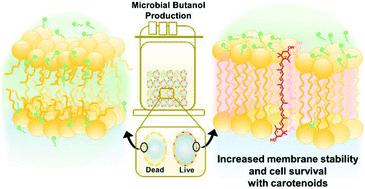当前位置:
X-MOL 学术
›
Environ. Sci.: Nano
›
论文详情
Our official English website, www.x-mol.net, welcomes your
feedback! (Note: you will need to create a separate account there.)
Carotenoids improve bacterial tolerance towards biobutanol through membrane stabilization
Environmental Science: Nano ( IF 5.8 ) Pub Date : 2021-1-6 , DOI: 10.1039/d0en00983k Geraldine W. N. Chia 1, 2, 2, 3, 4 , Thomas Seviour 2, 4, 5, 6, 7 , Staffan Kjelleberg 2, 4, 5, 8, 9 , Jamie Hinks 2, 4, 5
Environmental Science: Nano ( IF 5.8 ) Pub Date : 2021-1-6 , DOI: 10.1039/d0en00983k Geraldine W. N. Chia 1, 2, 2, 3, 4 , Thomas Seviour 2, 4, 5, 6, 7 , Staffan Kjelleberg 2, 4, 5, 8, 9 , Jamie Hinks 2, 4, 5
Affiliation

|
Microbial butanol production is an important sustainable energy option, but it is economically limited by poor process performance. Butanol is toxic and damages bacterial cell membranes, requiring cells to expend energy for survival rather than for butanol production. Here we explore the utility of two polar carotenoids, lutein (LUT) and zeaxanthin (ZEA), as molecular rivets to mitigate membrane fluidization by solvents and thus improve butanol tolerance in Escherichia coli. LUT and ZEA formed carotenoid-rich nanodomains in multilamellar vesicles, at molar ratios of 1 : 9 relative to phospholipids (10 mol%), which reduced the fluidization effect of 3.5% (v/v) butanol by 62%, as indicated by changes in generalized polarization values of the membrane fluidity probe, Laurdan. Additionally, membrane penetration of butanol was 38% lower in the same test system. In carotenoid-treated E. coli, butanol-induced membrane damage, determined by propidium iodide, decreased by up to 30%. Additionally, E. coli treated with both LUT and ZEA achieved a two-log increase in cell viability upon acute butanol exposure of 3.5% (v/v), compared to untreated cells. This is the first time that carotenoids have been used to fortify cellular membranes and reduce biomass loss due to butanol, thereby revealing a potential biotechnological application for carotenoids to improve the economics of microbial butanol production.
中文翻译:

类胡萝卜素通过膜稳定提高细菌对生物丁醇的耐受性
微生物丁醇生产是重要的可持续能源选择,但由于工艺性能差而在经济上受到限制。丁醇有毒,会损坏细菌细胞膜,需要细胞为生存而不是丁醇生产消耗能量。在这里,我们探讨了两种极性类胡萝卜素叶黄素(LUT)和玉米黄质(ZEA)的实用性,它们作为分子铆钉可减轻溶剂的膜流化作用,从而提高大肠杆菌中的丁醇耐受性。LUT和ZEA在多层囊泡中形成富含类胡萝卜素的纳米域,相对于磷脂(10 mol%)的摩尔比为1:9,这将3.5%(v / v)丁醇的流化作用降低了62%,如变化所示膜流动性探针Laurdan的广义极化值。此外,在同一测试系统中,丁醇的膜渗透率降低了38%。在类胡萝卜素处理的大肠杆菌中,由碘化丙啶确定的丁醇诱导的膜损伤最多可降低30%。此外,大肠杆菌与未经处理的细胞相比,经LUT和ZEA处理的细胞在急性丁醇暴露后3.5%(v / v)的条件下,细胞活力提高了2个对数。这是类胡萝卜素首次用于强化细胞膜并减少由于丁醇引起的生物量损失,从而揭示了类胡萝卜素在生物技术方面的潜在应用,以提高微生物丁醇生产的经济性。
更新日期:2021-01-06
中文翻译:

类胡萝卜素通过膜稳定提高细菌对生物丁醇的耐受性
微生物丁醇生产是重要的可持续能源选择,但由于工艺性能差而在经济上受到限制。丁醇有毒,会损坏细菌细胞膜,需要细胞为生存而不是丁醇生产消耗能量。在这里,我们探讨了两种极性类胡萝卜素叶黄素(LUT)和玉米黄质(ZEA)的实用性,它们作为分子铆钉可减轻溶剂的膜流化作用,从而提高大肠杆菌中的丁醇耐受性。LUT和ZEA在多层囊泡中形成富含类胡萝卜素的纳米域,相对于磷脂(10 mol%)的摩尔比为1:9,这将3.5%(v / v)丁醇的流化作用降低了62%,如变化所示膜流动性探针Laurdan的广义极化值。此外,在同一测试系统中,丁醇的膜渗透率降低了38%。在类胡萝卜素处理的大肠杆菌中,由碘化丙啶确定的丁醇诱导的膜损伤最多可降低30%。此外,大肠杆菌与未经处理的细胞相比,经LUT和ZEA处理的细胞在急性丁醇暴露后3.5%(v / v)的条件下,细胞活力提高了2个对数。这是类胡萝卜素首次用于强化细胞膜并减少由于丁醇引起的生物量损失,从而揭示了类胡萝卜素在生物技术方面的潜在应用,以提高微生物丁醇生产的经济性。











































 京公网安备 11010802027423号
京公网安备 11010802027423号